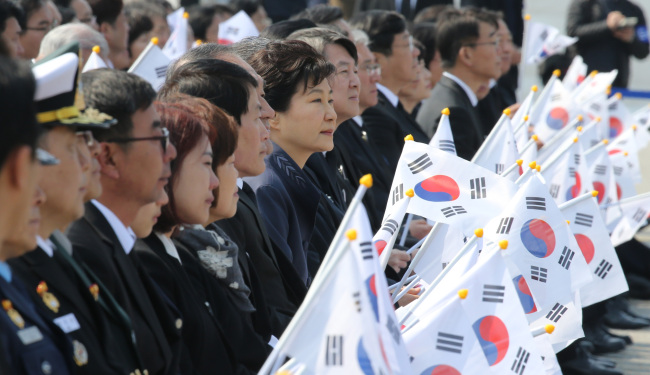Inter-Korea tensions rose another notch Friday after Pyongyang’s leader Kim Jong-un called on his military to be ready for a strike against Seoul’s leadership, a day after the South’s President Park Geun-hye ordered nationwide vigilance.
North Korea has been stepping up threats and simultaneously boasting its capacity for ballistic missile attacks. The bellicose rhetoric is nothing new, particularly amid U.N.-led sanctions and the annual Seoul-Washington military drills, but local observers say that the North is attempting to convey a message through repeated verbal provocations, particularly by its dictatorial leader himself.
“Rather than to carry out a military action right away, they are trying to boast their deterrence. For now, there is little possibility (of North Korea) attacking first unless it is attacked first,” said Koh Yoo-hwan, a North Korean studies professor at Dongguk University.
In a recent string of statements via its mouthpieces, the North claimed that it can miniaturize a nuclear warhead to be mounted onto a ballistic missile, that is has successfully conducted a solid-fuel rocket engine test, and that it has a large-caliber multiple rocket launcher that can directly strike the South’s capital.
 |
| This photo distributed by North Korea’s Rodong Sinmun on Friday shows Pyongyang’s leader Kim Jong-un inspecting his troops. (Yonhap) |
An official from the Joint Chiefs of Staff confirmed Friday that North Korean troops had held an artillery training on Thursday afternoon near the northeastern city of Wonsan. An unconfirmed number of fighter jets and bombers participated in the drill, which was supervised by Kim himself.
“Our military is well aware of the grave situation, and is keeping a keen eye on the North Korean military,” the official said.
President Park on Friday reiterated her warning against North Korea, and said that “reckless provocations” will lead to the regime’s demise.
“The government will cooperate with the international community and apply firm hands on North Korea, until it is free from the illusion of nuclear armament and realizes that change is inevitable for its survival,” she said during a memorial for the South Korean soldiers killed during clashes with North Korea in the West Sea. Saturday marks the sixth anniversary of the Cheonan warship sinking in 2010, when a North Korean torpedo attack on the ship left 46 South Korean sailors dead.
 |
| President Park Geun-hye watches a performance with other participants during a memorial for South Korean soldiers killed during clashes with North Korea in the West Sea, at the Daejeon National Ceremony on Friday. (Yonhap) |
South Korea’s Defense Ministry said that it takes the ballistic missiles and nuclear programs as a “real threat,” but added that the hermit kingdom’s claims are exaggerated. For example, the solid-fuel rockets are believed to be in their initial stages and the country’s ability to miniaturize a nuclear warhead has not been verified yet.
Michael Elleman, a missile engineer and senior fellow at the U.S.-based International Institute for Strategic Studies, said Thursday that North Korea is believed to be still many years away from developing their own rocket engines for the missiles. This would mean they have a limited stockpile, mostly relying on Soviet-era engines.
He added that he “wouldn’t imagine seeing even a 300 km-range, solid-propellant missile out of North Korea in the next five years.”
Yang Moo-jin, a professor of the University of North Korean Studies, said the North’s recent actions is as much targeted toward its own citizens as well as toward outsiders. In addition to sending out warnings toward the allies not to interfere with its system, Yang pointed out that it may also be directed at creating unity among North Korean citizens.
Joel Wit, one of the chief analysts of North Korea-monitoring website 38 North, was quoted by local media as saying that the North is playing some sort of mind game with the international community by revealing its nuclear and missile-related facilities. He reportedly said that such actions were in response to the recent sanctions, conveying warnings to other countries.
“Basically they are saying that the stronger the sanction gets, the bigger their threat of weapons of mass destruction will get,” said Koh of Dongguk University.
Some observers have warned that failure to thaw the frosty relations between the Koreas may spark radical actions by the North.
Cheong Seong-chang, senior research fellow at local think tank Sejong Institute, said that further escalation in the peninsula will likely lead to another nuclear testing. The 38 North reported earlier in the week that the North’s Punggye-ri nuclear appears ready for new tests based on satellite photos.
By Yoon Min-sik
(minsikyoon@heraldcorp.com)



